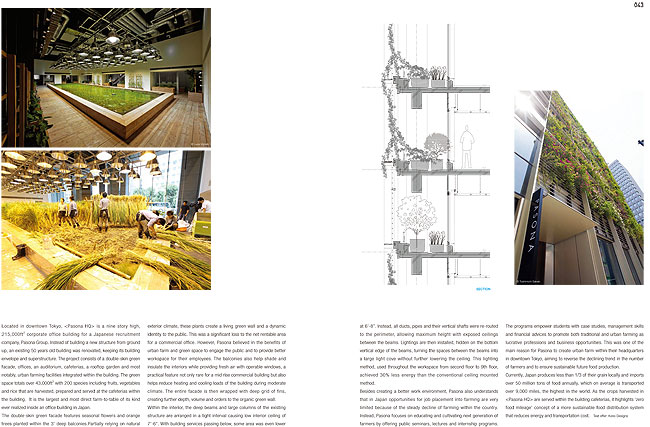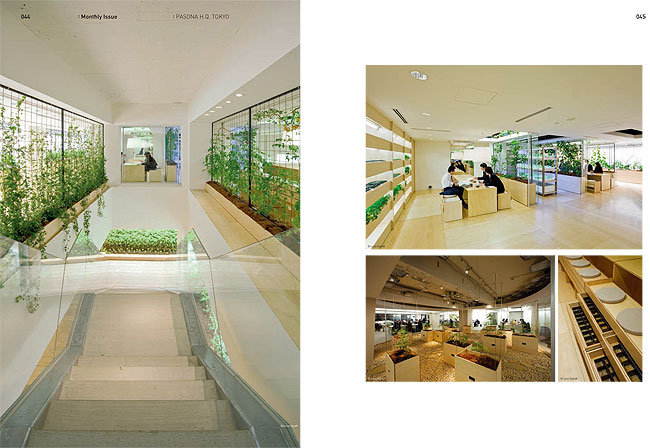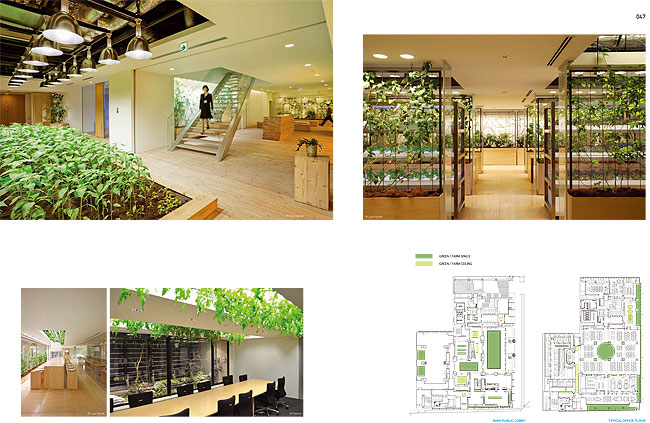PASONA H.Q. TOKYO
Kono Designs LLC




파소나 본사 빌딩 도쿄 도심에 위치한 <파소나 본사>는 일본의 인재파견회사 파소나 그룹을 위한 9층 높이, 215,000ft2 넓이의 기업사무소 건물이다. 건물을 지상에서부터 신축하지 않고, 기존의 50년 된 건물을 개축하여 건물의 외피와 상부구조를 보존했다. 이 프로젝트는 이중 외피의 녹화 입면과 사무실, 강당, 구내식당, 옥상정원, 그리고 가장 특징적인 건물 내부의 도심 텃밭 시설까지도 포함한다. 녹지 공간은 넓이가 총 43,000ft2를 넘는데, 여기서 200종의 과일과 야채, 쌀 등을 수확하고 다듬어 구내식당 메뉴에 사용한다. 이건 지금까지 일본의 사무소 건물에서 텃밭 농사를 식탁에 활용한 사례 중 가장 규모가 크고 직접적인 경우에 속한다.
이중 외피의 녹화 입면에서는 3ft 깊이의 발코니 안에 심어놓은 계절별 꽃과 오렌지 나무가 두드러진 요소로 나타난다. 외부의 자연 기후에도 일부 의존하는 이 식물들은 살아있는 녹화 벽면으로서, 공공을 향해 역동적인 정체성을 만들어낸다. 그리하여 상업용 사무실의 순 임대가능 면적에는 상당한 손실이 생겼다.
하지만 파소나 측은 도심텃밭과 녹화 공간이 공공을 끌어들이고 회사 직원들에게 더 나은 근무공간을 제공하는 혜택을 줄 것이라 믿었다. 발코니들은 실내에 그늘을 드리우며 단열 기능을 하고, 개폐식 창문을 활용해 신선한 공기를 유입시킨다. 이는 중층 규모의 상업건물에 흔치 않을 뿐만 아니라, 온화한 기후에서는 건물의 냉난방 부하를 줄이는 데 도움을 주는 실용적 요소다. 전체적인 입면은 깊은 수직 벽들이 이루는 격자로 덮음으로써, 유기적인 녹화 벽면에 더 큰 심도와 입체감, 질서를 부여하였다.
실내에서는 기존 건물의 깊은 보와 커다란 기둥들이 촘촘한 간격으로 배열되면서 천장고를 7ft 6in로 낮게 유지시킨다. 어떤 구역은 건물 설비가 밑에 지나가면서 천장고가 6ft 8in로까지 낮아지기도 한다. 대신 모든 덕트와 배관, 수직 굴대들은 주변부로 연결되도록 배열함으로써, 보 사이에서는 높이를 극대화한 노출 천장을 얻을 수 있었다. 그리고는 보의 맨 밑 수직 모서리상에 매입 조명을 설치하여, 천장고를 더 낮추지 않고도 보 사이의 공간들을 커다란 조명 공간으로 전환시켰다. 이러한 조명 기법은 2층부터 9층에 이르는 업무공간 전반에 사용되면서, 통상적인 천장 설치기법보다 30% 적은 에너지 소비를 가능케 했다.
파소나는 더 나은 업무환경을 만드는 것 이외에도, 일본 전역에서 지속적으로 쇠퇴하는 농업의 일자리 부족 현상을 인지하고 이에따라 대중 세미나와 강연, 인턴십 프로그램 등을 통해 차세대 농업인을 교육하고 길러내는 데에 초점을 두고 있다. 이 프로그램은 사례 연구와 경영 기술, 금융 자문을 통해 학생들이 전통 농업이건 도시 농업이건 수익성 있는 직무와 사업 기회로 발전시킬 수 있도록 지원한다. 이것이 파소나가 도쿄 도심에 있는 본사에 도심텃밭을 만드는 주된 이유 중 하나이며, 그 목적은 농민 수가 줄어드는 추세를 뒤집고 향후 지속 가능한 식량 생산을 보장하려는 것이다.
현재 일본은 곡물의 1/3 미만을 자국에서 생산하고 연간 5천만 톤이 넘는 식량을 해외에서 수입하는데, 수입되는 식량의 평균 운송 거리가 세계에서 가장 높은 수치인 9,000mile이다. 파소나 본사에서 수확되는 농작물들은 구내식당 메뉴로 활용되어 에너지와 운송 비용을 줄이는 만큼, 한층 지속 가능한 식량분배 시스템의‘ 제로 푸드 마일리지’ 개념을 강조한다.
글 제공: 코노 디자인
Located in downtown Tokyo, [Pasona HQ] is a nine story high, 215,000ft2 corporate office building for a Japanese recruitment company, Pasona Group. Instead of building a new structure from ground up, an existing 50 years old building was renovated, keeping its building envelope and superstructure.
The project consists of a double-skin green facade, offices, an auditorium, cafeterias, a rooftop garden and most notably, urban farming facilities integrated within the building. The green space totals over 43,000ft2 with 200 species including fruits, vegetables and rice that are harvested, prepared and served at the cafeterias within the building. It is the largest and most direct farm-to-table of its kind ever realized inside an office building in Japan.
The double-skin green facade features seasonal flowers and orange trees planted within the 3’ deep balconies.Partially relying on natural exterior climate, these plants create a living green wall and a dynamic identity to the public. This was a significant loss to the net rentable area for a commercial office.
However, Pasona believed in the benefits of urban farm and green space to engage the public and to provide better workspace for their employees. The balconies also help shade and insulate the interiors while providing fresh air with operable windows, a practical feature not only rare for a mid rise commercial building but also helps reduce heating and cooling loads of the building during moderate climate.
The entire facade is then wrapped with deep grid of fins, creating further depth, volume and orders to the organic green wall. Within the interior, the deep beams and large columns of the existing structure are arranged in a tight interval causing low interior ceiling of 7’-6”. With building services passing below, some area was even lower at 6’-8”. Instead, all ducts, pipes and their vertical shafts were re-routed to the perimeter, allowing maximum height with exposed ceilings between the beams.
Lightings are then installed, hidden on the bottom vertical edge of the beams, turning the spaces between the beams into a large light cove without further lowering the ceiling. This lighting method, used throughout the workspace from second floor to 9th floor, achieved 30% less energy than the conventional ceiling mounted method.
Besides creating a better work environment, Pasona also understands that in Japan opportunities for job placement into farming are very limited because of the steady decline of farming within the country. Instead, Pasona focuses on educating and cultivating next generation of farmers by offering public seminars, lectures and internship programs. The programs empower students with case studies, management skills and financial advices to promote both traditional and urban farming as lucrative professions and business opportunities. This was one of the main reason for Pasona to create urban farm within their headquarters in downtown Tokyo, aiming to reverse the declining trend in the number of farmers and to ensure sustainable future food production.
Currently, Japan produces less than 1/3 of their grain locally and imports over 50 million tons of food annually, which on average is transported over 9,000 miles, the highest in the world. As the crops harvested in [Pasona HQ] are served within the building cafeterias, it highlights ‘zero food mileage’ concept of a more sustainable food distribution system that reduces energy and transportation cost.
Text offer: Kono Designs
건축문화 2016년 12월호 [Monthly Issue]페이지 © 에이엔씨출판(주)